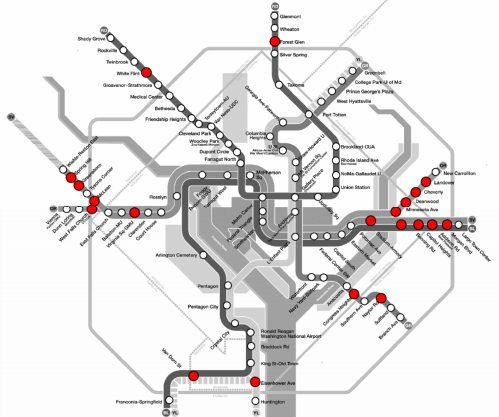WMATA is up against a budget deficit. Today, it floated ideas for some very big, very difficult changes.
WMATA is again estimating that its operating costs will far outpace revenues. To close the gap, the agency is considering closing several stations during off-peak hours, decreasing how often trains run, and cutting some bus routes.

Under WMATA’s new proposal, stations with red dots could only get service during rush hour. Image from WMATA.
The official budget proposal for FY2018 won’t come out until November, but a draft of a presentation that WMATA staff will give to the Board of Directors on Thursday gives some insight into big changes the agency is considering in order to close an estimated $275 million budget gap.
One option would eliminate service to 20 low-ridership stations during off-peak hours (midday, evening, and weekends). Many of these stations are located east of the Anacostia River, but White Flint and Tysons are also on the list.
Another option would eliminate service for bus routes with the highest operating costs per rider. One of the routes listed is Metro’s new bus rapid transit service, Metroway, which runs largely in dedicated bus lanes with bigger, better bus stops.
Some other options on the table include cutting more employees, increasing bus and rail fares, increasing peak-period rail headways from every six minutes to every eight, making weekend service less frequent, and asking Maryland, Virginia, and DC to contribute more funding.
These are bleak choices, but absent an infusion of funding, WMATA has to balance its budget somehow. What do you think it should do?
